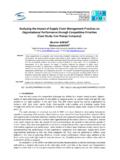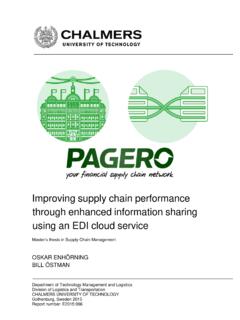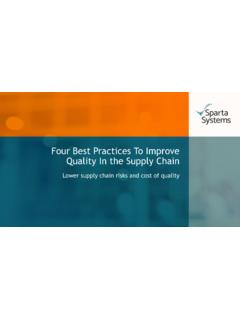Transcription of Improving Supply Chain Performance Using Lean and Agility ...
1 Proceedings of the 2013 International Conference on Information, Operations Management and Statistics (ICIOMS2013), Kuala Lumpur, Malaysia, September 1-3, 2013 Improving Supply Chain Performance Using Lean and Agility Concepts Mohamed K. Omar, Ru Min Sim Nottingham University Business School Malaysia-Selangor-Malaysia Abstract Supply - Chain management consists of departments collaborating to leverage strategic positioning and to improve operating efficiency. A Supply - Chain strategy is a channel of arrangement based on acknowledging collaboration. Therefore, the Supply - Chain operations require a managerial process that spans functional areas within individual firms and link trading partners and customers across the organisation boundaries. Companies involved with Supply - Chain management always strive to improve the Supply Chain Performance .
2 Lean, means the development of a value stream to eliminate waste, has been popular due to the success stories of the Japanese automotive and electronic industry. On the other hand, Agility means Using market knowledge and virtual corporation to exploit profitable opportunity in a volatile marketplace. This paper aims to investigate the idea of integrating lean and agile manufacturing concepts to improve the Supply Chain Performance . The paper intends to introduce a research framework that has been developed by the authors and discuss the literature that focuses on the use of the lean and agile concepts for Supply - Chain management..Keywords: lean, Agility , Supply Chain , Performance 1. Introduction The integrated Supply Chain perspective shifts traditional channel arrangements from loosely linked groups of independent business that buy and sell inventory to each other towards a managerially coordinated initiative to increase market impact, overall Performance , continuous improvement, and competitiveness.
3 In real-life, many complexities serve to cloud the simplicity of illustrating the Supply chains by linking several activities with each other. For example, many individual firms simultaneously participate in multiple and competitive Supply chains. This is made the Supply Chain the basic unit of competition, firms participating in several arrangements may confront loyalty issues related to confidentiality and potential conflict of interest. As it seems, operational Performance that deals with the time required to deliver a customer s order is used as a significant competitive weapon. Operational Performance involves delivery speed and consistency. Most of the customer wants fast delivery; however, fast delivery is of limited value if inconsistence from one order to the next. A customer gins little benefits when a supplier promises next-day delivery but frequently delivered late.
4 * Corresponding author. Tel.: +603-89248697; fax: +603-89248652. E-mail address: 2 Author name / ICIOMS Proceeding 00 (2013) 000 000 To achieve smooth operations, firms typically focus on delivery consistency first and then seek to improve delivery speed. A firm s operational Performance can be viewed in terms of its flexibility to accommodate unusual and unexpected customer requests. We may add that operational Performance is concerned with how a firm handles all customer requirements, including product and service failure. In a general way, product and service, reliability involves quality attributes of the firm. Besides the operational Performance , total cost minimization is a significant factor that must be considered in drafting competitive strategy when designing the Supply Chain . Therefore, operational Performance and cost Performance are two important aspects that affect the overall Performance of the Supply Chain which is used as a base for competition.
5 Based on what we have addressed so far, a firm may use Agility in its Supply Chain to enhance its operational Performance since a volatile marketplace will affect the operational Performance . On the other hand, it seems that lean that aims to eliminate waste has a great impact on cost Performance . This paper aims to investigate the idea of integrating lean and agile manufacturing concepts to improve the operating efficiency of the Supply Chain . The remaining of the paper is organized in the following way. In section 2, the literature review is provided. Section 3 presents the problem statement, section 4 the research framework is provided and in section 6, we present our proposed research method. Finally, conclusions are presented in section 6. 2. Literature review According to Wouters [1], Performance measurement is vital in strategy formulation and communication and in forming diagnostic control mechanisms by measuring actual results.
6 Gunasekaran and Kobu [2] suggested the following as the Performance measurement: (1) Identifying success,(2)Identifying if customer needs are met, (3) Better understanding of processes, (4)Identifying bottlenecks, waste, problems and improvement opportunities, (5) Providing factual decisions, (6) Enabling progress, (7) Tracking progress, facilitating a more open and transparent communication and co-operation. Through the use of survey, Gunasekaran et al. [3] develop a framework for Supply Chain Performance measurements that include metrics classification pointing out the important Performance measures. Yao and Liu [4] proposed the combination of economic value added (EVA), the balanced scorecard (BSC) and activity based costing (ABC) as an approach for measuring the Performance of the Supply Chain . Ho [5] suggested the use of the ERP as a tool for measuring the Performance of the Supply Chain based on the total cost.
7 Ho [5] used simulation approach to arrive at the conclusions that ERP can be used to measure Supply Chain Performance . Bernardes and Zsidisin [6] investigate the relation of strategic Supply - Chain management with the concepts of network embeddedness Martin and Patterson [7] pointed out that the three main Performance measures are inventory level, cycle time and financials. In their work, they explained that the effects of organizational structure, partnering, supplier agreements and process improvements on inventory level, cycle time and financials were investigated. Lean philosophy has become an integral part practiced in most of the manufacturing firms. It has been associated with excellent Performance and an important factor to provide competitive advantages (Krafcik, [8]; MacDuffie; [9]; Pil and MacDuffie, [10]). In addition, Dankbaar, [11] think that lean production will be the standard manufacturing model for the 21st century.
8 Lean production was introduced by Toyota under the names Toyota production system (TPS) or just-in-time (JIT) manufacturing in the 1960s (see Reichhart & Holweg, [12]; Taj, [13]). The approach is simply aims to eliminate waste and to improve productions by Using continuous improvement methodologies. The lean approach enables the use of various tools that will ensure to improve equipment downtime, cost of quality, levels of inventory and orders lead times. It has been used in the production system and Supply Chain and as a powerful competitive weapon. In addition, lean production is most frequently associated with elimination of waste commonly held by firms as excess inventory or excess capacity (machine and human capacity) to ameliorate the effects of variability in Supply , processing time, or demand. Therefore, to pursue lean production and minimize inventory, firms have Author name / ICIOMS Proceeding 00 (2013) 000 000 3 to manage variability in their Supply Chain , processing time, and demand (Hopp and Spearman, [14]; De Treville and Antonakis, [15]).
9 Agility maybe defined as a system that has strong ability to meet the rapidly changing needs of the market and this ability is characterized with speed and flexibility. A firm is said to be agile if the available resources are flexible and has the right speed to deal with the changing needs. Goldman et al. [16] defined Agility as a dynamic, context specific, aggressive change that embraces and pursues growth, success, profits, market share and customers. Gligor and Holcomb [17] explain that an agile organization can fulfil customer orders with exceptional speed and has the flexibility to introduce new products more often. In addition, Kidd [18] defines Agility as a combination of a number of enterprises such that each has some core skills or competencies that they contribute to a joint business operation. Moreover, Kumar and Motwani [19] think of a firm s Agility in terms of the firm ability to compete assuming responsiveness.
10 Miles and Snow ([20], [21]) provided an interesting definition for Agility from a manufacturing point view as the ability the capability to compete based on speed, flexibility, innovation pro activity, quality and profitability. In relation to Supply Chain , Mason-Jones et al. [22] explain that Agility used to improve total cycle time. The findings from the literature indicate that once the Supply Chain Performance measures are identified, then it is possible to use some of the elements offered by lean and Agility concepts to improve the Performance of the Supply Chain . Enhancing the Performance of the Supply Chain will in our opinion contributes towards the use of the Supply Chain as a competitive tool. 3. Problem statement Supply Chain Performance is usually measured Using in inventory levels, the cycle time and financials.









